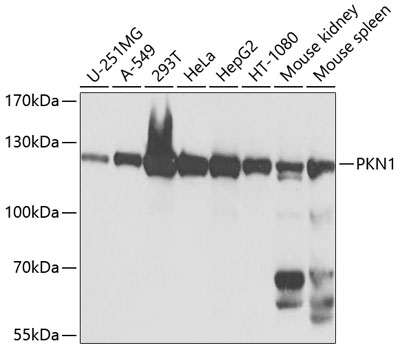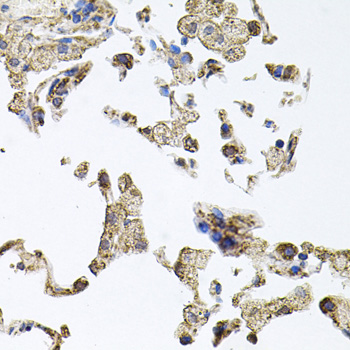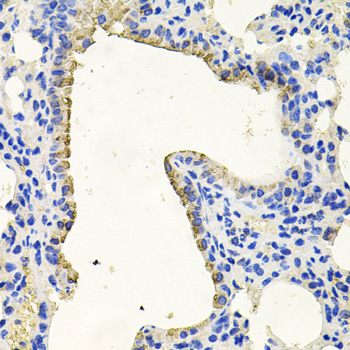-
Product Name
PKN1 Polyclonal Antibody
- Documents
-
Description
Polyclonal antibody to PKN1
-
Tested applications
WB, IHC
-
Species reactivity
Human, Mouse, Rat
-
Alternative names
PKN1 antibody; DBK antibody; PAK-1 antibody; PAK1 antibody; PKN antibody; PKN-ALPHA antibody; PRK1 antibody; PRKCL1 antibody; protein kinase N1 antibody
-
Isotype
Rabbit IgG
-
Preparation
Antigen: Recombinant fusion protein containing a sequence corresponding to amino acids 1-300 of human PKN1 (NP_002732.3).
-
Clonality
Polyclonal
-
Formulation
PBS with 0.02% sodium azide, 50% glycerol, pH7.3.
-
Storage instructions
Store at -20℃. Avoid freeze / thaw cycles.
-
Applications
WB 1:500 - 1:1000
IHC 1:50 - 1:100 -
Validations

Western blot - PKN1 Polyclonal Antibody
Western blot analysis of extracts of various cell lines, using PKN1 antibody at 1:1000 dilution.Secondary antibody: HRP Goat Anti-Rabbit IgG (H+L) at 1:10000 dilution.Lysates/proteins: 25ug per lane.Blocking buffer: 3% nonfat dry milk in TBST.Detection: ECL Basic Kit .Exposure time: 5s.

Immunohistochemistry - PKN1 Polyclonal Antibody
Immunohistochemistry of paraffin-embedded mouse brain using PKN1 antibody at dilution of 1:100 (40x lens).

Immunohistochemistry - PKN1 Polyclonal Antibody
Immunohistochemistry of paraffin-embedded human lung using PKN1 antibody at dilution of 1:100 (40x lens).

Immunohistochemistry - PKN1 Polyclonal Antibody
Immunohistochemistry of paraffin-embedded mouse lung using PKN1 antibody at dilution of 1:100 (40x lens).
-
Background
PKC-related serine/threonine-protein kinase involved in various processes such as regulation of the intermediate filaments of the actin cytoskeleton, cell migration, tumor cell invasion and transcription regulation. Part of a signaling cascade that begins with the activation of the adrenergic receptor ADRA1B and leads to the activation of MAPK14. Regulates the cytoskeletal network by phosphorylating proteins such as VIM and neurofilament proteins NEFH, NEFL and NEFM, leading to inhibit their polymerization. Phosphorylates 'Ser-575', 'Ser-637' and 'Ser-669' of MAPT/Tau, lowering its ability to bind to microtubules, resulting in disruption of tubulin assembly. Acts as a key coactivator of androgen receptor (ANDR)-dependent transcription, by being recruited to ANDR target genes and specifically mediating phosphorylation of 'Thr-11' of histone H3 (H3T11ph), a specific tag for epigenetic transcriptional activation that promotes demethylation of histone H3 'Lys-9' (H3K9me) by KDM4C/JMJD2C. Phosphorylates HDAC5, HDAC7 and HDAC9, leading to impair their import in the nucleus. Phosphorylates 'Thr-38' of PPP1R14A, 'Ser-159', 'Ser-163' and 'Ser-170' of MARCKS, and GFAP. Able to phosphorylate RPS6 in vitro.
Related Products / Services
Please note: All products are "FOR RESEARCH USE ONLY AND ARE NOT INTENDED FOR DIAGNOSTIC OR THERAPEUTIC USE"
